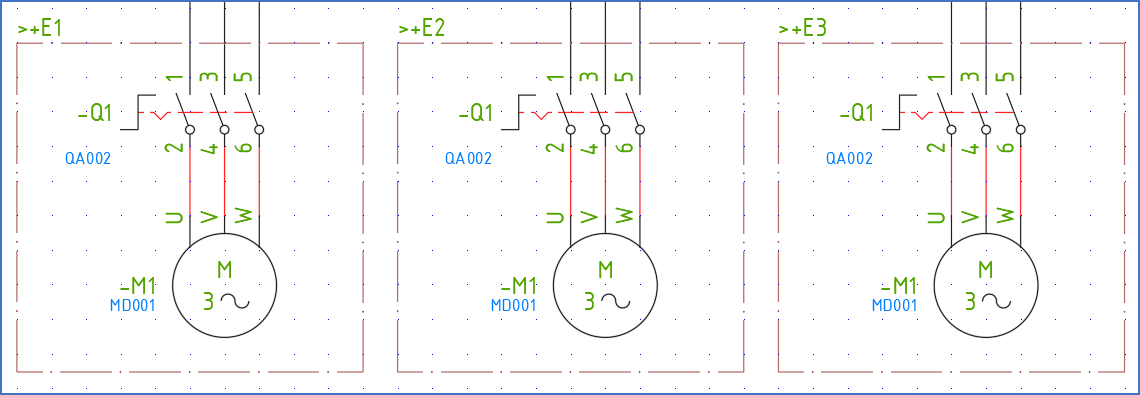|
<< Click to Display Table of Contents >> Abbreviated notation |
  
|
|
<< Click to Display Table of Contents >> Abbreviated notation |
  
|
The item designations often tend to turn out as rather long and ungainly, especially when using multiple levels. For that reason, an abbreviated form of notation is almost always used. In our example, the item designation is simply written as –F1 in the circuit diagram. Plant/function and location are made evident from the specification of plant/function and location in the upper left corner of the drawing frame. That notation form is not only supported by cadett ELSA, but also by the IEC standard.
Demo IEC1355 English is a sample project which is included in cadett ELSA at delivery.
In the first sheet of this demonstration project also other location designations than +D3 (which is defined in the upper left corner) are present. Consider for instance the three motors. They do all have other location designations than the one specified in the drawing frame. The location designation for the first motor is for instance +E1. That is specified in a so-called "boundary box", which surrounds the motor and the safety switch. Please note that the location designation is specified as >+E1, not simply +E1. What is the difference?
When using multi-level item designations, which is the normal case, location designations, as well as plant/function designations, specified directly in symbols or in boundary boxes, are by default treated as sub-levels of the surrounding designations. In this case, the surrounding location designation is +D3, which is defined in the upper left corner of the drawing sheet. If only +E3 would have been specified, that would be interpreted as +D3+E3.
The "greater than" sign (">") is defined in IEC1346 (and EC750) and means "top level", "start here" or "disregard the surroundings", depending on how you want to view it. In any case, specifying the location as >+E3, means +E3, and nothing else.

Figure 9: The motors in the "Demo IEC1355 English" project with their location designation
If multi-level item designations are not used, a boundary box simply has priority over the surroundings. No "greater than sign" should be used in that case.
There is also a third possibility to specify location designations. You can enter them into an attribute of the symbol itself. The same rules with levels and "greater than" applies for that too. Please note however, that this is regarded as yet another level, meaning that a location designation specified in a symbol inside a boundary box, would be interpreted as being on the third level, with the designation in the upper left corner of the drawing frame as top level, and the boundary box as the second level. This is of course under the assumption that multi-level item designations are used.
Example |
|
|---|---|
Upper left corner |
+D3 |
Boundary box |
+E1 |
Symbol |
+A1 |
Resulting location designation |
+D3+E1+A1 |
To make a summary, there are three different ways of specifying location designations. The upper left corner of the drawing frame is the "top level", the boundary box defines "sub levels" of that, and the attributes of the symbols, define yet another sub-level. Exactly the same rules are applicable for plant/function designations.
Here can also be mentioned that boundary boxes can be nested. A boundary box within another boundary box is interpreted as defining yet another sub-level. In this way, an arbitrary number of levels may be defined.